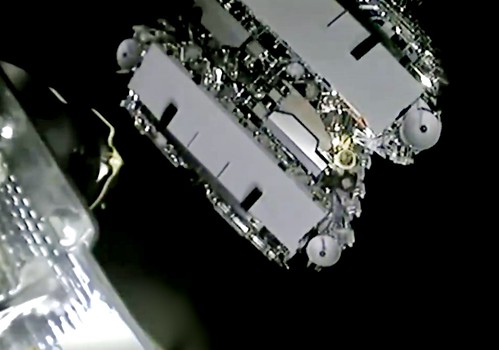
The arrival of weight loss drug Ozempic poses an existential challenge for companies reliant on selling diets and weight loss plans. CC-licensed photo by Chemist4U on Flickr.
You can sign up to receive each day’s Start Up post by email. You’ll need to click a confirmation link, so no spam.
On Friday, there’s another post due at the Social Warming Substack at about 0845 UK time.
A selection of 10 links for you. Non-fattening. I’m @charlesarthur on Twitter. On Mastodon: https://newsie.social/@charlesarthur. Observations and links welcome.
I tracked an NYC subway rider’s movements with an MTA ‘feature’ • 404 Media
Joseph Cox:
»
In the mid-afternoon one Saturday earlier this month, the target got on the New York subway. I knew what station they entered the subway at and at what specific time. They then entered another station a few hours later. If I had kept monitoring this person, I would have figured out the subway station they often start a journey at, which is near where they live. I would also know what specific time this person may go to the subway each day.
During all this monitoring, I wasn’t anywhere near the rider. I didn’t even need to see them with my own eyes. Instead, I was sitting inside an apartment, following their movements through a feature on a Metropolitan Transportation Authority (MTA) website, which runs the New York City subway system.
With their consent, I had entered the rider’s credit card information—data that is often easy to buy from criminal marketplaces, or which might be trivial for an abusive partner to obtain—and punched that into the MTA site for OMNY, the subway’s contactless payments system. After a few seconds, the site churned out the rider’s travel history for the past seven days, no other verification required.
The news presents a significant privacy risk from a feature that is supposedly designed for individuals to check their own travel history, but which in reality is wide open to abuse.
…“Obviously this is a great fit for abusers who live with their victims or have physical access, however brief, to their wallets,” Eva Galperin, the director of cybersecurity at activist organization the Electronic Frontier Foundation (EFF) and who has extensively researched how abusive partners use technology, told 404 Media. “Credit card info is not a goddamn unique identifier.”
«
Galperin makes a reasonable point: the extreme situation is very undesirable. Adding a username/password barrier would make sense (though in the case of people living with their abusers, the latter will just demand the username and password).
unique link to this extract
The $76bn diet industry asks: what to do about Ozempic? • WSJ
Andrea Petersen, Rolfe Winkler and Sara Ashley O’Brien:
»
Annick Lenoir-Peek, a lawyer from Durham, N.C., has struggled with her weight since adolescence. She has tried Atkins and keto and spent thousands of dollars over decades on weight-loss efforts and programs such as Noom, Nutrisystem and WeightWatchers.
Since starting [weight loss drug] Ozempic in late November, she has lost around 30lb [14kg]. Her cholesterol and glucose levels have improved, and she can eat far fewer calories without feeling hungry, she says. She has felt few side effects and has more energy than when she tried calorie-restricted diets. Currently on a trip through Eastern Europe, she says she is doing more tours than she would have at a higher weight.
People such as Ms. Lenoir-Peek—among the diet business’s most reliable customers—are sparking an existential crisis for the industry, which rang up $76bn in sales in 2022 from weight loss and medical programs, diet soda and low-calorie frozen food, gym memberships and other categories, according to research firm Marketdata LLC.
Drugs such as Ozempic, Wegovy and Mounjaro have upended the business of losing weight in America. They are shaping up to be blockbusters for Novo Nordisk, which makes Ozempic and Wegovy, and Eli Lilly, which makes Mounjaro. The drugs are also ripping up long-held beliefs that diet, exercise and willpower are the way to weight loss.
“I think they [the new drugs] are going to transform the industry of weight loss in a pretty big way,” says Alex Fuhrman, senior research analyst at Craig-Hallum Capital Group LLC. “The traditional approach to weight loss has been the only game in town for a very long time except for more drastic surgical interventions. The behavioural approach to weight loss is going to be under pressure now.”
«
This was always going to be the collateral damage – or existential risk – from Ozempic and other GLP-1 drugs: why do you need to torture yourself with diets when you could just take this completely safe medication?
unique link to this extract
Researchers discover common origin behind major childhood allergies • MedicalXpress
»
Several major childhood allergies may all stem from the community of bacteria living in our gut, according to a new study led by researchers at the University of British Columbia and BC Children’s Hospital.
The research, published in Nature Communications, identifies gut microbiome features and early life influences that are associated with children developing any of four common allergies—eczema, asthma, food allergy and/or hay fever. The findings could lead to methods of predicting whether a child will develop allergies, and ways to prevent them from developing at all.
“We’re seeing more and more children and families seeking help at the emergency department due to allergies,” said Dr. Stuart Turvey, professor in the department of pediatrics at UBC and an investigator at BC Children’s Hospital Research Institute, and co-senior author on the study. “Hundreds of millions of children worldwide suffer from allergies, including one in three children in Canada, and it’s important to understand why this is happening and how it can be prevented.”
The study is one of the first to examine four distinct school-aged pediatric allergies at once. While these allergic diseases each have unique symptoms, the Turvey lab was curious whether they might have a common origin linked to the infant gut microbiota composition.
“These are technically different diagnoses, each with their own list of symptoms, so most researchers tend to study them individually,” says Dr. Charisse Petersen, co-senior author on the paper and postdoctoral fellow in the Turvey lab. “But when you look at what is going wrong at a cellular level, they actually have a lot in common.”
«
Very interesting: a shift in the microbiome could explain the apparent rise in allergic incidence. Bacteria as the underlying triggers of disease and the microbiome are the new frontiers in medicine; so much coming out now.
unique link to this extract
The Mystery of the Bloomfield Bridge • Tyler Vigen
Tyler got intrigued by something one day:
»
Why is this bridge here?
This pedestrian bridge crosses I-494 just west of the Minneapolis Airport. It connects Bloomington to Richfield. I drive under it often and I wondered: why is it there? It’s not in an area that is particularly walkable, and it doesn’t connect any establishments that obviously need to be connected. So why was it built?
I often have curious thoughts like this, but I dismiss most of them because if I answered all of them I would get nothing else done. But one day I was walking out of a Taco Bell and found myself at the base of the bridge. That only raised MORE questions! Why did the bridge just lead to some grass? Why isn’t there a sidewalk? What is the point? It makes no sense!
«
It’s a fabulous tale, with a bit of the shaggy dog about it. (TL;DR it does actually bridge the road.)
unique link to this extract
Google to sell maps data to companies building solar products • CNBC
Jennifer Elias:
»
The company plans to sell access to new APIs (application programming interfaces) with solar and energy information and air quality, according to materials viewed by CNBC.
Among the new offerings will be a Solar API, which could be used by solar installers like SunRun and Tesla Energy and solar design companies like Aurora Solar, according to a list of example customers viewed by CNBC. Google also sees customer opportunities with real estate companies like Zillow, Redfin, hospitality companies like Marriott Bonvoy, and utilities like PG&E.
Some of the data from the Solar API will come from a consumer-focused pilot called Project Sunroof, a solar savings calculator that originally launched in 2015. The program allows users to enter their address and to receive estimated solar costs such as electric bill savings and the size of the solar installation they’ll need. It also offers 3D modeling of the roofs of buildings and nearby trees based on Google Maps data.
Google plans to sell API access to individual building data, as well as aggregated data for all buildings in a particular city or county, one document states. The company says it has data for over 350m buildings, according to documents, up significantly from the 60m buildings it cited for Project Sunroof in 2017.
One internal document estimates the company’s solar APIs will generate revenue between $90m and $100m in the first year after launch. There’s also a potential to connect with Google Cloud products down the line, documents state.
«
As Elias points out, the revenue will be tasty for Google, which wants to make more from maps (which remain expensive to maintain).
unique link to this extract
The SynthID watermark from Google DeepMind can detect AI-generated images • The Verge
David Pierce:
»
[Google DeepMind CEO, Demis] Hassabis and his team have been working on a tool for the last few years, which Google is releasing publicly today. It’s called SynthID, and it’s designed to essentially watermark an AI-generated image in a way that is imperceptible to the human eye but easily caught by a dedicated AI detection tool.
The watermark is embedded in the pixels of the image, but Hassabis says it doesn’t alter the image itself in any noticeable way. “It doesn’t change the image, the quality of the image, or the experience of it,” he says. “But it’s robust to various transformations — cropping, resizing, all of the things that you might do to try and get around normal, traditional, simple watermarks.” As SynthID’s underlying models improve, Hassabis says, the watermark will be even less perceptible to humans but even more easily detected by DeepMind’s tools.
That’s as technical as Hassabis and Google DeepMind want to be for now. Even the launch blog post is sparse on details because SynthID is still a new system. “The more you reveal about the way it works, the easier it’ll be for hackers and nefarious entities to get around it,” Hassabis says. SynthID is rolling out first in a Google-centric way: Google Cloud customers who use the company’s Vertex AI platform and the Imagen image generator will be able to embed and detect the watermark. As the system gets more real-world testing, Hassabis hopes it’ll get better. Then Google will be able to use it in more places, share more about how it works, and get even more data on how it works.
«
So this is essentially steganography – hiding a message in an image. That usually gets broken (ie, the message is lost) through other conversions. And the problem is also that just because an image doesn’t contain this sikrit c0d3 doesn’t mean it isn’t AI-generated – just that SynthID (probably) wasn’t used on it.
unique link to this extract
We analyzed millions of ChatGPT user sessions: visits are down 29% since May; programming assistance is 30% of use • SparkToro
Rand Fishkin:
»
Programming is the largest use case, with 29.14% of all prompt series falling into this use-case. It’s also the clearest/least ambiguous. I hand-checked 100+ of each prompt series (an arduous, but fascinating task) to confirm the classifier’s accuracy, and programming help (with writing specific bits of code, formatting code, catching errors in code, and more) was present in every one ChatGPT marked as such.
As others have often pointed out, the tool excels at programming-related tasks. Little wonder it’s such a popular use case.
Next up is education — but not just primary or secondary education. Personal knowledge or interest pursuits and professional knowledge for work purposes are both included here as well. Same with content creation — some is clearly personal (D&D dungeon masters needing riddles or quests for their adventures was a recurring favorite in the dataset) while others are professional (“write me a 500 word blog post about detroit plumbing problems” – presumably a content marketer tired of writing their own material).
Sales and marketing use-cases overlap with content creation, but I chose to keep these separate to help see only those sessions that could only be classified as helping sales+marketing professionals with their tasks (analysis of analytics, questions about which channels to promote their products in, ad optimization tasks, and even messaging/promotion help were all in the dataset).
«
“SEO” appeared in just over 2% of prompts, suggesting that it’s already being used to game web search. When programming stops being the top use, I think we’ll be able to say that ChatGPT has properly arrived.
unique link to this extract
Fukushima: China accused of hypocrisy over its own release of wastewater from nuclear plants • The Guardian
Amy Hawkins and Justin McCurry:
»
As China bans all seafood from Japan after the discharge of 1m tonnes of radioactive water from the ruined Fukushima Daiichi nuclear power plant into the Pacific Ocean, Beijing has been accused of hypocrisy and of using the incident to whip up anti-Japanese sentiment.
Scientists have pointed out that China’s own nuclear power plants release wastewater with higher levels of tritium than that found in Fukushima’s discharge, and that the levels are all within boundaries not considered to be harmful to human health.
On Thursday, Tokyo Electric Power (Tepco), the company that manages the plant, began pumping water containing radioactive tritium into the sea, starting a wastewater discharge process that is expected to take at least 30 years. The plan has been approved by the UN’s atomic watchdog, the International Atomic Energy Agency (IAEA) and the Japanese government.
On Friday, Tepco said rapid tests of samples taken from the first batch of released wastewater showed radioactivity levels well within safe limits. “We confirmed that the analysed value is equal to the calculated concentration and that the analysed value is below 1,500 becquerels per litre,” a Tepco spokesperson, Keisuke Matsuo, told reporters. The national safety standard is 60,000 becquerels a litre.
“We will continue to conduct analysis every day over the next one month and even after that, maintain our analysis effort,” Matsuo added. “By providing swift, easy to understand explanations we hope to dispel various concerns.”
China has condemned the discharge, with the customs agency saying it risks the “radioactive contamination of food safety”. China’s foreign ministry said it was an “extremely selfish and irresponsible act”.
«
Good that someone is pointing out that China is simply playing a PR game here. People are Losing Their Minds over the Fukushima water discharge, which I’d say is safer to drink than many – most? – English rivers. The radioactivity levels are absolutely infinitesimal, but people hear that word and starting doing Münch painting impressions.
unique link to this extract
Most cancer screenings don’t extend life, study finds – but don’t cancel that appointment • CNN
Jen Christensen:
»
Early diagnosis has been shown to improve cancer outcomes, which is why the American Cancer Society and the World Health Organization say routine screening is an important public health strategy. Overall cancer mortality worldwide has decreased significantly, falling 33% since 1991, in part due to early detection as well as advances in treatment and declines in smoking.
The latest study, published Monday in the journal JAMA Internal Medicine, found that of the six most common cancer screenings, only colorectal cancer screening with sigmoidoscopy — in which doctors check the lower part of the colon or large intestine for cancer — seemed to make a difference in extending someone’s life. It may extend life by a little more than three months, the research says.
The researchers looked at clinical trials that involved at least nine years of follow-up reporting and found no significant difference in lifetime gain with the other most common cancer screening tests: mammography for breast cancer, colonoscopy, fecal occult blood testing or endoscopy (FOBT), prostate-specific antigen tests, and computed tomography for current or former smokers.
“We do not advocate that all screening should be abandoned,” the researchers wrote. “Screening tests with a positive-benefit-harm balance measured in incidence and mortality of the target cancer compared with harms and burden may well be worthwhile.”
The authors of the new research suggest that rather than emphasize that cancer screenings save lives, doctors should be clearer about their absolute benefits, harms and burdens.
«
The argument against is that inevitably there are false positives, which lead to anxiety and more screening. Compared to cancer, though, anxiety and more screening seems a small price. (Plus what about the upside of relief if the false positive is discovered?)
unique link to this extract
Managed to death: how Canada turned its forests into a carbon bomb • Bulletin of the Atomic Scientists
Jessica McKenzie:
»
To illustrate the scale and pace of our metastasizing forest carbon crisis, I turned to data in Canada’s official national greenhouse gas inventory, plus recent wildfire data from the European Union’s Earth Observation Program. The resulting chart shows the cumulative amount of CO2 that’s been added to the atmosphere from Canada’s managed forest since 1990.
The falling green line at the start of the chart shows that in the early 1990s, the forest was a valuable carbon sink, helping to slow global warming. Back then, new forest growth absorbed more CO2 from the air than was emitted by logging, wildfire and decay.
That all changed after 2001, the tipping point year for Canada’s managed forest.
As the rising red line on the chart shows, since that year, the forest has emitted more CO2 than it has absorbed. A lot more. Logging, wildfires, insects and the many forms of decay are now turning trees into CO2 faster than the forest can grow back.
That pumped billions of tonnes of climate fuel into the atmosphere—even before accounting for this year’s epic wildfires (shown by the dashed line). With those included, the cumulative total since the tipping point year is now around 3,700 million tonnes of CO2 (MtCO2).
«
| • Why do social networks drive us a little mad? • Why does angry content seem to dominate what we see? • How much of a role do algorithms play in affecting what we see and do online? • What can we do about it? • Did Facebook have any inkling of what was coming in Myanmar in 2016? Read Social Warming, my latest book, and find answers – and more. |
Errata, corrigenda and ai no corrida: none notified











